Feasibility Studies and Problem Discovery in ICT Projects
Assignment 1 for INFT6500 course on Accounting Information Systems, involving a group assignment with individual marking. Each student will complete a literature review and exercise based on a case study narrative.
39 Pages11536 Words438 Views
Added on 2023-06-07
About This Document
This article discusses the importance of feasibility studies and problem discovery in ICT projects. It explains the different types of feasibility studies and their benefits. It also discusses the process of problem discovery and definition in IT projects. The article highlights the importance of technology incorporation in business operations and the emerging trends in information technology. It uses Maria’s Aquariums business problem as a case study to explain the concepts.
Feasibility Studies and Problem Discovery in ICT Projects
Assignment 1 for INFT6500 course on Accounting Information Systems, involving a group assignment with individual marking. Each student will complete a literature review and exercise based on a case study narrative.
Added on 2023-06-07
ShareRelated Documents
ANFT6500: Assignment 1
Name
Institution
Professor
Course
Date
Name
Institution
Professor
Course
Date

Topic One: Feasibility Studies in ICT projects
Introduction
Feasibility study is one of the major undertaking in the project management that helps
organizations achieve proposed business solution. There are different types of feasibilities but
the most important part in this case is economic feasibility study (Abdullah et al., 2010). In
general, feasibilities are being used by organizations to plan business operations, pin point
business strengths and weaknesses as well as attract more customers due to increased business
efficiency. Organizational project should undergo through several feasibility studies such as
technical, operational, economic and ethical. Economic feasibility study is an important aspect as
it helps organization assess required project costs, anticipated benefits and risks that are coupled
with planned business ventures. An analysis in feasibility is not necessarily rigorous, neither
should it be expensive factoring all possible challenges and risks. In this case, feasibility would
be of great importance as it will help Raymond increase efficiency in business operations,
improve customer satisfaction as well as increase volume of sales (Avgerou, 2010). Important to
note is that, to make Maria’s Aquariums business successful, Raymond would be required to
adopt an Information System (IS) in to business daily operations. This will make it possible to
consolidate all business operations and operational data for ease of decision making.
Rationale
Technology incorporation in business operations has been one of the major success
factors organizations are putting in place. One of the main reason for using Information System
in business operations is to increase business operational efficiency, consolidate all the records
for ease of decision making and minimize errors in business data that may result to losses. The
Introduction
Feasibility study is one of the major undertaking in the project management that helps
organizations achieve proposed business solution. There are different types of feasibilities but
the most important part in this case is economic feasibility study (Abdullah et al., 2010). In
general, feasibilities are being used by organizations to plan business operations, pin point
business strengths and weaknesses as well as attract more customers due to increased business
efficiency. Organizational project should undergo through several feasibility studies such as
technical, operational, economic and ethical. Economic feasibility study is an important aspect as
it helps organization assess required project costs, anticipated benefits and risks that are coupled
with planned business ventures. An analysis in feasibility is not necessarily rigorous, neither
should it be expensive factoring all possible challenges and risks. In this case, feasibility would
be of great importance as it will help Raymond increase efficiency in business operations,
improve customer satisfaction as well as increase volume of sales (Avgerou, 2010). Important to
note is that, to make Maria’s Aquariums business successful, Raymond would be required to
adopt an Information System (IS) in to business daily operations. This will make it possible to
consolidate all business operations and operational data for ease of decision making.
Rationale
Technology incorporation in business operations has been one of the major success
factors organizations are putting in place. One of the main reason for using Information System
in business operations is to increase business operational efficiency, consolidate all the records
for ease of decision making and minimize errors in business data that may result to losses. The

rationale behind this study is to make Maria’s Aquariums business successful by reducing errors,
make it possible for Raymond to manage all branches from headquarters without much travel,
eliminate paper work as well as increase profit margin.
Literature review
Feasibility studies are being used by organizations to plan business operations. In this
case, Raymond would require feasibility analysis to come up project costs, ethical or legal
implication, time frame analysis, and operational requirements as well as technical project needs
(Janssen & Klievink, 2012). In this review, Maria’s Aquariums business projections would focus
on economic feasibility study of executing required support projects. The main focus would be
project implementation cost benefit analysis.
Methods of Literature review
To understand Maria’s Aquariums needs, project team would be expected to analyze
aspects through which some of the similar businesses have been able to make operations more
efficient. Implementation of Information Technology in business operations has been found to be
the key success factor. In order to make operations simple, organizations have been adopting
Information System (IS) in their daily operations. Maria’s Aquariums adoption of IS in its
operations would make it possible for Raymond to manage all operations from headquarters as
many other businesses have been able to similar business. Learning from other business would
be an important aspect as it will help evaluate both challenges and opportunities encountered
during IS actualization (Chang et al., 2012). Related search may not be limited to organizations
with IS only as this might not give realistic data. Organizations that have not implemented IS
systems would be of great importance because they will help identify some of the reasons that
make it possible for Raymond to manage all branches from headquarters without much travel,
eliminate paper work as well as increase profit margin.
Literature review
Feasibility studies are being used by organizations to plan business operations. In this
case, Raymond would require feasibility analysis to come up project costs, ethical or legal
implication, time frame analysis, and operational requirements as well as technical project needs
(Janssen & Klievink, 2012). In this review, Maria’s Aquariums business projections would focus
on economic feasibility study of executing required support projects. The main focus would be
project implementation cost benefit analysis.
Methods of Literature review
To understand Maria’s Aquariums needs, project team would be expected to analyze
aspects through which some of the similar businesses have been able to make operations more
efficient. Implementation of Information Technology in business operations has been found to be
the key success factor. In order to make operations simple, organizations have been adopting
Information System (IS) in their daily operations. Maria’s Aquariums adoption of IS in its
operations would make it possible for Raymond to manage all operations from headquarters as
many other businesses have been able to similar business. Learning from other business would
be an important aspect as it will help evaluate both challenges and opportunities encountered
during IS actualization (Chang et al., 2012). Related search may not be limited to organizations
with IS only as this might not give realistic data. Organizations that have not implemented IS
systems would be of great importance because they will help identify some of the reasons that
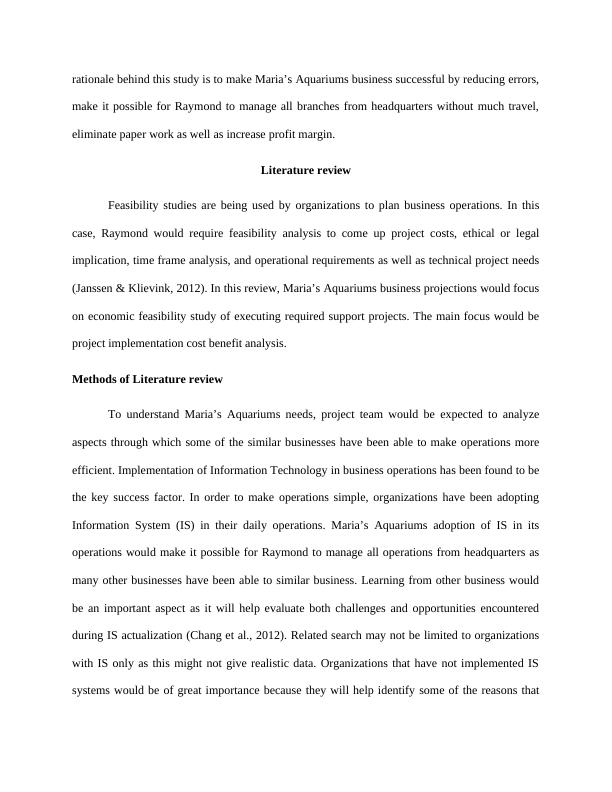
might have hindered IS implementation. Organization that run similar IS to the one proposed by
Maria’s Aquariums would serve as an example as it will be possible to determine possible
scenarios either challenges or opportunities associated with Technological implementation.
Economic Feasibility study
In an investment business appraisal, economic evaluation is quite important. It has to put
into consideration all factors that are quantifiable, measurable and can be compared with
organizational operational monetary value. Economic evaluation is usually considered in
conjunction with other project aspects in order to make it viable investment decisions (Wade et
al., 2010). The right business investment decision helps organization execute subject project
successfully. For Maria’s Aquariums business, the right investment would involve business
resources being utilized wisely with a goal of generating future operational benefits. In order for
Maria’s Aquariums business to be successful, the expected benefits ought to be favorable when
compared to required resources to execute the project.
Cost/ Benefit Analysis
Assessment of economic feasibility should be prior to business execution and
management should have analyzed all project implementation related costs and benefits.
Raymond should understand that, all capital investment costs should be considered because they
usually affect business evaluation. Basically, all cost estimation is regarded as an intuitive
process that makes it possible to predict all associated final results of expenditure in capital
investment. It is important for project managers to understand that, it is quite difficult to give an
exact estimation of cost and benefits for any project (Mubarak, Al-Mubaraki & Busler, 2010). At
the initial stages of project execution, implementation costs should be done adequately as well as
Maria’s Aquariums would serve as an example as it will be possible to determine possible
scenarios either challenges or opportunities associated with Technological implementation.
Economic Feasibility study
In an investment business appraisal, economic evaluation is quite important. It has to put
into consideration all factors that are quantifiable, measurable and can be compared with
organizational operational monetary value. Economic evaluation is usually considered in
conjunction with other project aspects in order to make it viable investment decisions (Wade et
al., 2010). The right business investment decision helps organization execute subject project
successfully. For Maria’s Aquariums business, the right investment would involve business
resources being utilized wisely with a goal of generating future operational benefits. In order for
Maria’s Aquariums business to be successful, the expected benefits ought to be favorable when
compared to required resources to execute the project.
Cost/ Benefit Analysis
Assessment of economic feasibility should be prior to business execution and
management should have analyzed all project implementation related costs and benefits.
Raymond should understand that, all capital investment costs should be considered because they
usually affect business evaluation. Basically, all cost estimation is regarded as an intuitive
process that makes it possible to predict all associated final results of expenditure in capital
investment. It is important for project managers to understand that, it is quite difficult to give an
exact estimation of cost and benefits for any project (Mubarak, Al-Mubaraki & Busler, 2010). At
the initial stages of project execution, implementation costs should be done adequately as well as
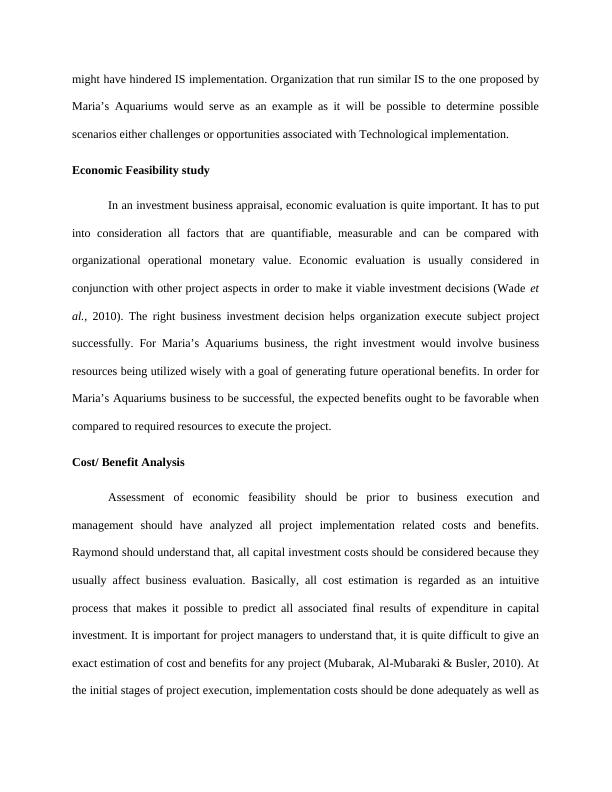
have some alternatives for comparison purpose. During implementation of Information
Technology (IT) or Information System (IS) project, Raymond should first consider all costs
associated with software and hardware. Despite tangible costs, it would be important to consider
other intangible costs such as labor. Total Cost of Ownership (TCO) is one of the most
prominent methodology used by managers to evaluate both direct and indirect costs involved in
the project implementation. TCO is believed to be a holistic of all IT costs involved during
implementation. This is an implication that, all costs have been considered during project
estimation for purpose of giving an exact match of the project needs. The following costs should
be considered during Information System (IS) project actualization; costs on all hardware related
to end users, costs involved in acquisition of operating licenses, deployment costs of both
hardware and software, infrastructure installation costs, Costs that are related to security
breaches, costs on insurance of the company and training costs (Ahlan & Sukmana, 2014).
Time and value of invested capital
Project managers have a variety of choices to use in project cost assessment such as “Net
Present Value (NPV) and Discounted Cash Flow Rate of Return” (De-Moor et al., 2015). Project
managers are free to use any method of project cost analysis while estimating project monetary
value. With variety of methods to choose from, project managers should be able to select the
most favorable methodology to use when evaluating monetary value in any project. These
methodologies are applicable at various instances as they are dependent on the project
undertaking. Project estimation are usually done at present monetary value but benefits would be
done using future value. Other economic feasibility methodologies are Return on Investment
(ROI) which is believed to be equivalent to individual net cash receipts of the Information
System project. Maria’s Aquariums should have an evaluation before investing on any project to
Technology (IT) or Information System (IS) project, Raymond should first consider all costs
associated with software and hardware. Despite tangible costs, it would be important to consider
other intangible costs such as labor. Total Cost of Ownership (TCO) is one of the most
prominent methodology used by managers to evaluate both direct and indirect costs involved in
the project implementation. TCO is believed to be a holistic of all IT costs involved during
implementation. This is an implication that, all costs have been considered during project
estimation for purpose of giving an exact match of the project needs. The following costs should
be considered during Information System (IS) project actualization; costs on all hardware related
to end users, costs involved in acquisition of operating licenses, deployment costs of both
hardware and software, infrastructure installation costs, Costs that are related to security
breaches, costs on insurance of the company and training costs (Ahlan & Sukmana, 2014).
Time and value of invested capital
Project managers have a variety of choices to use in project cost assessment such as “Net
Present Value (NPV) and Discounted Cash Flow Rate of Return” (De-Moor et al., 2015). Project
managers are free to use any method of project cost analysis while estimating project monetary
value. With variety of methods to choose from, project managers should be able to select the
most favorable methodology to use when evaluating monetary value in any project. These
methodologies are applicable at various instances as they are dependent on the project
undertaking. Project estimation are usually done at present monetary value but benefits would be
done using future value. Other economic feasibility methodologies are Return on Investment
(ROI) which is believed to be equivalent to individual net cash receipts of the Information
System project. Maria’s Aquariums should have an evaluation before investing on any project to
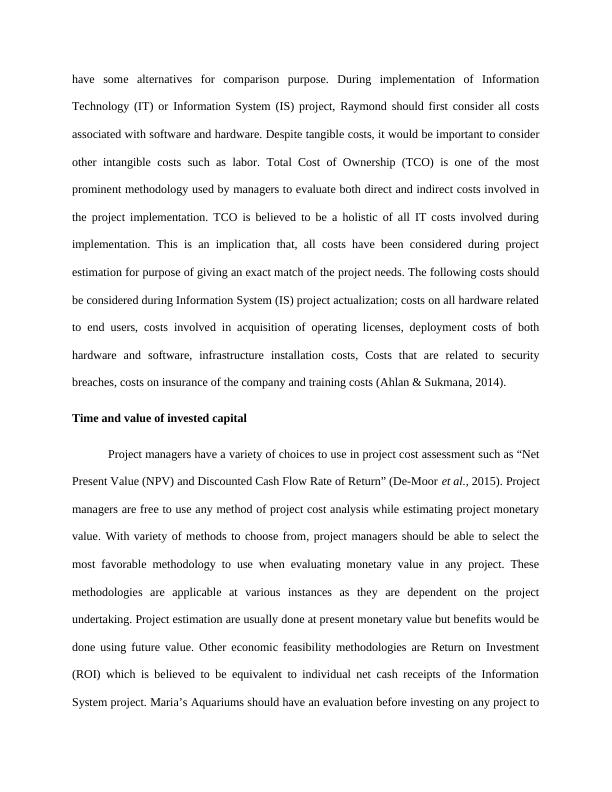
make sure actualization of the project provides highest Return on Investment (Steffey &
Anantatmula, 2011). Profitability Period (PP) is another method which is used to give an
estimate of investments profitability.
Importance of feasibility study in project management
Feasibility study has several benefits to an organization which has desire to have the right
prediction of expected benefits before committing its resources and time (Nawi, Rahman &
Ibrahim, 2011). Since feasibility study provides a clear roadmap of the project before starting its
actualization, it is used to provide a picture of the entire project in advance. First, once feasibility
has been done, project team is able to have a focus on what is expected at each stage of project
implementation. In this case, Maria’s Aquariums project team would be able to determine all
project requirements before it can even be started (Pade-Khene, Mallinson & Sewry, 2011).
Next, with viable project feasibility study, organizations are able to identify some new hidden
project opportunities. These new opportunities can be identified if project team have taken an
intensive evaluation of all aspects through which organization would realize maximum benefits.
Despite new opportunities being identified, it is still possible to pin point on some project
weakness that might limit project implementation efforts. Additionally, feasibility study unveils
new business alternatives which can be used to maximize business profits. According to Wade et
al. (2010), new business alternative makes it possible to expand business operations by either
adding new product brand in to the business or extending business to new locations. Moreover,
with viable feasibility study, it is possible to increase chances of business success. It is possible
to evaluate many parameters that can enhance business success rate if the right feasibility has
been done. Parameter evaluation unveils more business success factors by analyzing each
factor’s ability to steer business growth as well as challenges presented by each business
Anantatmula, 2011). Profitability Period (PP) is another method which is used to give an
estimate of investments profitability.
Importance of feasibility study in project management
Feasibility study has several benefits to an organization which has desire to have the right
prediction of expected benefits before committing its resources and time (Nawi, Rahman &
Ibrahim, 2011). Since feasibility study provides a clear roadmap of the project before starting its
actualization, it is used to provide a picture of the entire project in advance. First, once feasibility
has been done, project team is able to have a focus on what is expected at each stage of project
implementation. In this case, Maria’s Aquariums project team would be able to determine all
project requirements before it can even be started (Pade-Khene, Mallinson & Sewry, 2011).
Next, with viable project feasibility study, organizations are able to identify some new hidden
project opportunities. These new opportunities can be identified if project team have taken an
intensive evaluation of all aspects through which organization would realize maximum benefits.
Despite new opportunities being identified, it is still possible to pin point on some project
weakness that might limit project implementation efforts. Additionally, feasibility study unveils
new business alternatives which can be used to maximize business profits. According to Wade et
al. (2010), new business alternative makes it possible to expand business operations by either
adding new product brand in to the business or extending business to new locations. Moreover,
with viable feasibility study, it is possible to increase chances of business success. It is possible
to evaluate many parameters that can enhance business success rate if the right feasibility has
been done. Parameter evaluation unveils more business success factors by analyzing each
factor’s ability to steer business growth as well as challenges presented by each business
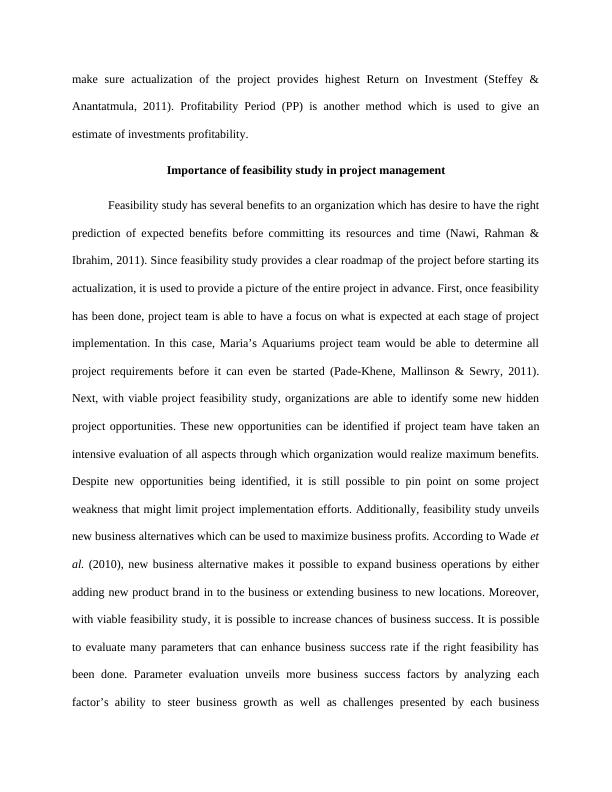
operational factor (Thapa & Saebo, 2014). Finally, feasibility study evaluation helps organization
to come up with a valid conclusion of undertaking an IT project. In this case, Raymond would be
able to understand if Maria’s Aquariums would benefit from IT incorporation in to business
operations.
Conclusion
Feasibility study provides an opportunity to an organization to examine project
implementation benefits and risks. With proper use of feasibility study, Maria’s Aquariums
project implementation would be of great importance. It would be possible to estimate the costs
required to implement Information System. Project team would be expected to implement viable
project goals by evaluating all avenues through which an organization would benefit from
implementation of IT in business operations. Raymond rationale on IT actualization in business
operations are; efficiency, consolidation of data for purpose of decision making and increase
profit margin. Among all feasibility studies, economic would be of great interest because it
focuses on cost benefits analysis as well investment capital required.
to come up with a valid conclusion of undertaking an IT project. In this case, Raymond would be
able to understand if Maria’s Aquariums would benefit from IT incorporation in to business
operations.
Conclusion
Feasibility study provides an opportunity to an organization to examine project
implementation benefits and risks. With proper use of feasibility study, Maria’s Aquariums
project implementation would be of great importance. It would be possible to estimate the costs
required to implement Information System. Project team would be expected to implement viable
project goals by evaluating all avenues through which an organization would benefit from
implementation of IT in business operations. Raymond rationale on IT actualization in business
operations are; efficiency, consolidation of data for purpose of decision making and increase
profit margin. Among all feasibility studies, economic would be of great interest because it
focuses on cost benefits analysis as well investment capital required.

Topic Two: Problem Discovery and Definitions in ICT Projects
Introduction
Project management is one of the complex undertaking in Information Technology (IT)
field. Any project requires problem discovery as well as definitions in order to be able to come
up with best solutions (Dossick & Neff, 2011). A problem is usually defined after it has been
discovered as this is what results to innovations. Problem discovery is done by evaluating
possible areas that can be improved to come up with a more scalable solution. IT projects are
quite challenging and coming up with an idea that can solve existing solution require an
intensive evaluation. Once a market gap has been identified, the next step is to define the
problem for other people to be able to understand it. Problem definition in IT projects should be
clear, precise and focused for ease of understanding. For Raymond to come up with successful
solution to Maria’s Aquariums business problem, a market gap should be identified and solution
be developed to solve the problem (Perrow, 2011). In this case, the problem discovery would be
the need to come up with an IT project to solve Raymond need to consolidate all business
operations and increase operational efficiency. On the other hand, problem definition would
explain all business need to make it simple to analyze and try to get possible solution. There are
several ways through which an organization can end up with problem discovery (Pahl & Beitz,
2013). Engaging employees by requesting them to give out their suggestions on possible means
that can be used to improve service delivery as well as possible means of implementing these
suggestions.
Background information
Introduction
Project management is one of the complex undertaking in Information Technology (IT)
field. Any project requires problem discovery as well as definitions in order to be able to come
up with best solutions (Dossick & Neff, 2011). A problem is usually defined after it has been
discovered as this is what results to innovations. Problem discovery is done by evaluating
possible areas that can be improved to come up with a more scalable solution. IT projects are
quite challenging and coming up with an idea that can solve existing solution require an
intensive evaluation. Once a market gap has been identified, the next step is to define the
problem for other people to be able to understand it. Problem definition in IT projects should be
clear, precise and focused for ease of understanding. For Raymond to come up with successful
solution to Maria’s Aquariums business problem, a market gap should be identified and solution
be developed to solve the problem (Perrow, 2011). In this case, the problem discovery would be
the need to come up with an IT project to solve Raymond need to consolidate all business
operations and increase operational efficiency. On the other hand, problem definition would
explain all business need to make it simple to analyze and try to get possible solution. There are
several ways through which an organization can end up with problem discovery (Pahl & Beitz,
2013). Engaging employees by requesting them to give out their suggestions on possible means
that can be used to improve service delivery as well as possible means of implementing these
suggestions.
Background information
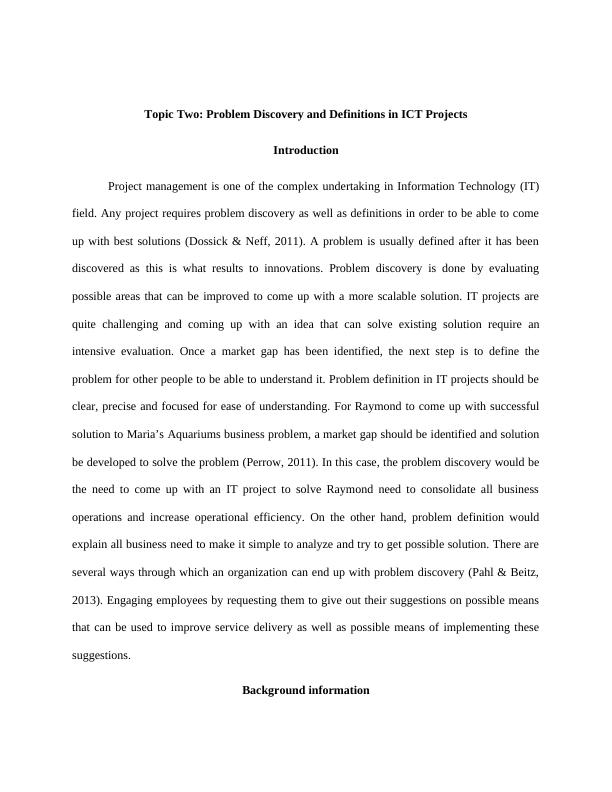
End of preview
Want to access all the pages? Upload your documents or become a member.
Related Documents
ICT Project Management: Life Cycle Phases and Toolslg...
|10
|2162
|485
Feasibility Study of Maria's Aquariumlg...
|8
|1284
|185
A Literature Review on Project Management in ICT Projects at Maria’s Aquariumlg...
|7
|1592
|435
Implementation of Accounting Information Systemlg...
|17
|4154
|467
Accounting Information System: Marias Aquarium case scenariolg...
|8
|1869
|185
Adoption Of Information System Discussion 2022lg...
|7
|2245
|23
